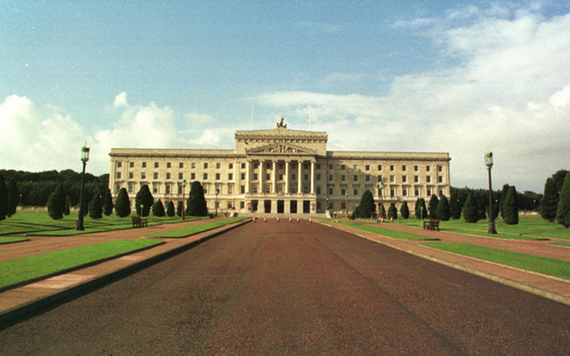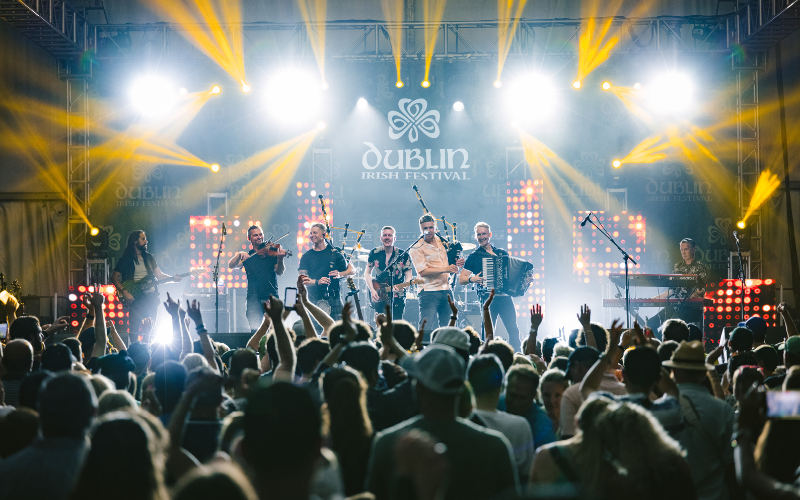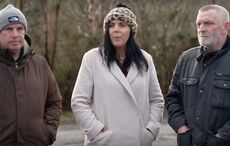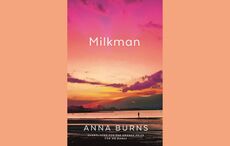The Lawyers Alliance for Justice in Ireland came to Ireland to express solidarity with our brothers and sisters at the Bar whom we perceived to be on the front lines of justice.
“Better to Light One Candle Than to Curse the Darkness”
From February 1992 through the end of 2002, more than 125 American lawyers, judges, professors, law students and activists traveled to Northern Ireland, at their own expense, to observe Diplock Court trials, cooperate with Irish and British lawyers, meet with judges, including Lord Chief Justices, visit prisons and community centers and participate in community justice inquiries.
Why did we come, what did we do and what did we find?
Why the Irish Innocence project came to Northern Ireland

Pat Finucane.
American lawyers came to Ireland to express solidarity with our brothers and sisters at the Bar whom we perceived to be on the front lines of justice. We saw a brave young solicitor, Patrick Finucane, shot down at Sunday evening dinner with his wife and small children. We read that he had been castigated by a member of the British Parliament for carrying out the highest professional duty, representing unpopular clients before the court.
We somewhat grandly termed ourselves, The Lawyers Alliance for Justice in Ireland. I recall enjoying tea with a Lord Chief Justice who remarked that the name of our group itself was an affront since it implied that there was an absence of justice in Northern Ireland. A somewhat rocky start, but it set the tone for candor in our exchanges with judges, lawyers and government officials.
Read more: Agent 6137 and the murder of Pat Finucane
We came to Ireland because we felt that we could make a difference in the manner in which lawyers and litigants were treated within the legal system.
Not that we were better or had the answers from America, but simply because we had a different approach to applying the law in times of conflict. Our prosecutors, defense lawyers and judges from Chicago, New York, California, New Jersey, Arizona and elsewhere had dealt with urban riots, gang wars, organized crime, gun crimes and violent racial and ethnic attacks. We were diverse in race and ethnicity and religion. We did not hail from an Ivory Tower but rather the streets and courts and neighborhood centers of some of the toughest neighborhoods of a country in turmoil.
We also came to Ireland because we were asked to come by Irish families whose sons and daughters were in trouble with the authorities and for whom they held out little hope of receiving justice in the Diplock Courts.
Finally, I should remark that we came because we received an overwhelming welcome and support from you, the members of the legal community of Northern Ireland. I can honestly say that in the many meetings I and my colleagues had with Irish and British lawyers and judges in the North, not once did we hear an expression of resentment or objection to our presence or mission.
Read more: Buzzing Belfast is learning to leave its troubles behind
What did The Lawyers Alliance for Justice in Ireland do?

A mural in West Belfast remembering the 1916 Easter Rising. CIARAN TIERNEY
In 1991 I was practicing as a trial lawyer in Denville, New Jersey, a comfortable small town approximately 35 miles west of New York City. Although my grandfather John Patrick McCarron had grown up in the New Lodge neighborhood of Belfast, he left for Philadelphia in the early 1900s. He qualified as a joiner in a firm run by a man named Bob Dixon, whose forebearers were from the Protestant community in Northern Ireland.
For reasons which are not entirely clear, Grandpa McCarron never looked back to Belfast, or at least let on to his grandchildren that he did. We grew up knowing vaguely that there were problems in the north of Ireland but they did not directly impact us.
Then in 1991, my wife Aud and I heard about Project Children, a program which brought Irish children from troubled areas of the North to spend a summer with American families.
We signed on and soon found ourselves on July 4 waiting with our 3 children for the arrival of a bus from Kennedy Airport with about 40 kids from the North.
Our boy, who I will call Sean, stepped down from the big bus, wide-eyed and close-mouthed. His name tag said Sean and listed the Lynches as the host family.
For 24 hours, Sean was mum. We could only get his name and the fact that he was from Divis. The next day, July 5, was his 11th birthday. After a small party, he started talking and did not stop until the bus picked him up at the end of August for the return trip to Kennedy Airport.
One of the other youngsters who traveled with Sean was Billy from East Belfast. Billy settled in with Pastor Smith, head of the Methodist Church in nearby Dover NJ, and the Pastor’s family.
When the first Sunday rolled around, my wife, a Lutheran from Norway, thought it a good idea that Sean and Billy should get to know each other.
Read more: Batman’s Michael Keaton became American father to Irish Troubles kid
I asked Sean if he knew any Protestant children in Belfast. He responded to the effect, “NO WAY”.
I pressed on and asked if he had ever seen any Protestant kids. He reluctantly answered “Yes”. I assumed it might have been a sporting match and inquired what they were doing.
“THROWING STONES AT US” Sean replied.
And what were you doing, I asked.
“THROWING STONES AT THEM” he answered.
Hoping to hit a brighter note I said, “Well, you know Sean, Mrs. Lynch is a Protestant.”
Sean’s eyes widened and he glanced toward the door, perhaps looking for a quick exit.
But when I explained that she was a “Lutheran” he relaxed. Apparently, there was a limited supply of Lutherans in Divis and the Shankill.
After a very friendly church service and the support of Pastor Smith, we all headed over to the Stewart’s Root Beer stand for hot dogs and soda. Billy and Sean hit it off and soon became fast friends.
After Sean and Billy returned to Belfast, our New Jersey families missed them. So it was decided that my wife and I would fly to Ireland and visit Sean and Billy and their families. Thus in November of 1991, Aud and I flew to London, took a train to Fishguard, Wales, a ferry to Ireland and a roundabout bus route to the North.
We made it to Derry but missed the express bus to Belfast. Thus we arrived late evening at Glengall Street Station. We assured Sean’s Mom that we were quite happy to walk over the footbridge to their home in Divis. She advised that was not possible and shortly she and Sean arrived to escort us through a neighborhood watch into Divis. The fear of incursion by loyalists was palpable.

British soldiers on parade in Belfast city centre in 2008, welcomed by loyalist supporters. Photo: Laura Hutton/Photocall Ireland
The next morning, before dawn, we awoke to what I believed to be a road construction crew and backhoe or digger. Instead, to my shock, I opened the curtains to see an Army vehicle with a spotlight shining directly on our bedroom window. And a soldier behind a mounted gun. The curtain was closed, covers pulled up and questions arose as to my good sense or lack thereof.
Welcome to Belfast.
That morning Sean’s sister was heading up to visit a boyfriend held at Crumlin Road Jail. I was surprised that this young man, about 18 years old, had been held for many months without a bail hearing or trial on a charge of being in a home where a gun was found. The fact that he was a visitor to the home and had no prior criminal record apparently was of no significance.
Read more: Belfast Relatives for Justice leader to speak in New York City
At the jail, I had trouble gaining entry, despite the display of various impressive cards and photos we Americans carry. Then a handsome young solicitor, later identified as Kevin Winters, showed up and vouched for my character.
Upon return to New Jersey, I researched the Diplock Court system and met Jean Forest, an activist from Hoboken, and Richard Harvey, a British barrister who also practiced human rights law in New York. I learned of the plight of the Ballymurphy and Beechmount Boys of West Belfast who were held in the Crumlin Road Jail on the charge of being lookouts for the IRA in a failed rocket attack on an army patrol.
One thing led to another, and soon, in February of 1992, I returned to Belfast with a diverse entourage of 24 American trial lawyers, judges, prosecutors and human rights activists.

Soliders from the British Army with their Riot gear. 12/7/1985. Pic Eamonn Farrell/RollingNews.ie.
We stayed in West Belfast with the families of the Ballymurphy 7 and Beechmount 5. We met with their lawyers. Names that come to mind, by no means exclusive or in any order of priority, include, Eamann McMenamin, Peter Madden, Barry McDonald, Arthur Harvey, Barra McGrory and Angela Ritchie.
In subsequent visits, we came to know the courageous work of Kevin Winters, Joe McVeigh, Niall Murphy and Paul Pierce.
We visited the youngsters in jail. What struck us was their youth and the fact that they were housed together with adult men.
We later learned the wing which housed the youngsters was subject to a rocket attack.
Ultimately, thanks to outstanding advocacy, the Crown’s case fell apart since the exculpatory evidence was withheld from defense counsel. A few of the boys had pled to minor charges but the majority were set free with all charges dismissed. But 18 months in jail on spurious charges was a heavy price to pay for these young men for being in the wrong place at the wrong time, namely hanging out on a street corner in West Belfast at the time of a violent incident—not an uncommon occurrence.
From that simple beginning, our presence expanded to twice a year visits to the North. We shared tea and biscuits with two Lord Chief Justices, engaged in robust discussion with judges of the high court, crown prosecutors and defense counsel. We spent many hours at The Maze/ Long Kesh Prison. Our rapport with the Governors, particularly Martin Mugg and Duncan McLaughlin, was such that we were turned loose in particular H Blocks with a reminder to call when we were ready to leave. As one of the governors remarked, “We basically run a prisoner of war camp here. We control the perimeter and so long as rules of order and respect are maintained, the residents control their own lives.”

Long Kesh also known as the Maze Prison Camp, viewed from Maze Presbyterian Church, Maze. Image: WikiCommons.
We met with the Chief Constable Ronnie Flanagan, Secretary of State Mo Mowlam, Sir Louie Blom Cooper, Independent Commissioner for the Holding Centers; Queens Counsel and barristers and solicitors from Belfast and elsewhere. We joined in seminars at the Law Faculty of Queen’s University.
And we met the people of the North—a vibrant, hopeful and generous people who opened their homes and hearts to us.
Community groups organized and conducted inquiries into cases of alleged collusion and questionable shootings of civilians. Our lawyers and judges, along with Irish and British lawyers and law professors, were invited to sit as panel members and reach findings of fact and responsibility.
I sat on the New Lodge 6 Inquiry, a shocking case in which six innocent civilians were shot dead by members of the British Army, who had set up a failed ambush of the IRA. The dead included teenagers on their way home from Friday night cinema and a member of a Catholic ex-servicemen's club who came to the aid of one of the wounded youngsters.
The British Ministry of Defense was invited to participate but ignored the request and ignored the findings of the international panel that the shootings were completely unjustified.
Other community panels included those into state killings of Patrick Shanahan; the failure of the RUC to protect Paul Thompson and the Army killing of Fergal Carragher.
What did we find?

The funeral of Rosemary Nelson. Image: Leon Farrell/Photocall Ireland.
Over the course of more than ten years interaction with the legal system in the North of Ireland we found the following:
1. Members of the Bar have a strong sense of responsibility to see that justice is done regardless of the obstacles and personal danger. We all know the fate of courageous lawyers Patrick Finucane and Rosemary Nelson. I should note that Rosemary was a personal friend and an outstanding lawyer who played by the rules of the jurisdiction, achieved great success for her clients and was cut down by a car bomb within yards of her children’s school. This was a great tragedy for her and her dear children and loyal husband Paul but also for all members of the law fraternity. And yet after all the years that have passed since March of 1999, no one in government or elsewhere has been called to account. And Sheena Campbell, a law student and single mother was shot dead in the York Hotel Lounge while joining with fellow students after the end of class. Her “offense” was the lawful support of a political candidate.
2. These sad cases point out the fact that some in the security forces, in politics and the public at large identified the lawyer with the client. If the client is deemed an enemy of the state or an enemy of a particular community, then his or her lawyer is also the enemy. Much more needs to be done by the leaders of the bench and bar, the churches and the government to dispel such falsehoods. Of great concern are recent reports of a resurgence of the demonization of defense lawyers in the North.
3. Certain questionable principles applicable in the past to the courts in Northern Ireland produced miscarriages of justice.
4. Those include extensive detention and questioning of an individual without the benefit of counsel.
5. The failure of a civilian to rebut the accusation of a police officer was later be used in court as evidence of guilt.
6. The common purpose doctrine whereby an individual can be found guilty of the ultimate criminal act, such as homicide, even though the individual did not engage in that act or know of its intended commission. The most egregious application of this doctrine that comes to mind is the infamous Casement Park case in which three men were found guilty of the killing of two British soldiers by members of the IRA despite the fact that the three men were not members of the IRA nor were they present at the killing.
7. The Court of Appeal has been remarkably robust in rectifying certain miscarriages of justice. I think of the cases of Chris Walsh, Sean Clinton, Colin Duffy and Steven Larkin. In the Larkin case, Lawyers Alliance member Rick O’Meara was privileged to submit a brief to the court which some say was instrumental in Larkin’s exoneration. This is particularly significant since these were high-profile cases in which the government and many in the public were convinced o the guilt of the defendants.

Widow of murdered solicitor Pat Finucane, Geraldine, brother of Pat Finucane, Dermot, daughter Katherine (front) son Michael (back) their solicitor Peter Madden who founded his solicitors firm with Pat in 1979 and son John. Image: Photocall Ireland.
8. The role of NGO’s and community groups in the North is outstanding and highly effective. Early and reliable champions of justice have been the Committee for the Administration of Justice, the Pat Finucane Center, Relatives for Justice and British Irish Rights Watch. Dedicated individuals from these organizations welcomed us from the inception of our involvement and guided our efforts into sensible and productive endeavors. These groups serve all members of Northern Irish society regardless of religion or political affiliation.
9. Over the years we met with several of the Lord Chief Justices including Brian Hutton, Robert Carswell, Brian Kerr and, most recently, Sir Declan Morgan. In certain matters our views were far apart. But the exchanges were candid, and, I believe, beneficial to both the Justices and the American lawyers and judges. At the least, we understood the challenges to the judiciary in a society in conflict and the Justices became aware of critical views of the system they administered.
Conclusion

Stormont Assembly in Northern Ireland. Image: RollingNews.ie.
When lawyers think back to the reasons we decided to pursue a career in the law and to undergo the rigors of study and bar examination, we acknowledge that a desire to earn a living and care for our families played a significant part.
But equally strong motivation, I submit, was a desire to make our communities fairer and more just for all inhabitants. I daresay that this sentiment applies with equal strength to Irish, British and American members of the bar and bench.
Our license to practice law was, and is, a tool to do good, to help the wrongly accused, to lift the burden of discrimination and poverty from the less powerful in our society.
For those who have been elevated to the judiciary, I dare say it has not been all sweetness and light. You are under constant scrutiny and inevitably some litigants and counsel are disgruntled by your rulings. But you would not have weathered the storm, but for your conviction that the law and justice must be served, regardless of the position or power of those who appear before you.
When distinguished members of the bar look back at a life in the law, knowing that the last brief or trial is complete, you will be able to say that you have made those tough decisions; that the race has been run as best possible and that you have been blessed to have been a member of a noble and honorable profession.
The author is a Member of the Bar of the Supreme Court of the United States and lower federal and state courts. He served in the United States Peace Corps, graduated from Georgetown University Law School and has practiced law for more than 40 years. Lynch served as National Coordinator of the Lawyers Alliance for Justice in Ireland from 1992 to 2002. The Alliance was a voluntary association of more than 125 American lawyers, judges and related professionals dedicated to the promotion of the rule of law in Northern Ireland.




Comments